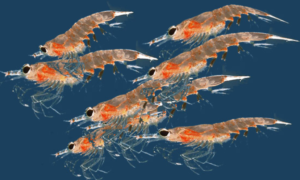 If you’re anything like me, the first time you heard of krill was in Finding Nemo, right before Marlin and Dory get eaten by the whale, and since then you’ve heard about them here and there in nature documentaries, and they’re always getting eaten. Although it’s true that they’re basically always getting eaten, but don’t you go thinking that that means they’re not important. In fact, the reason they’re so important is the fact that they’re at pretty much the bottom of the food chain. Krill can be found in all the oceans of the world, and are a source of food for whales, fish, squid, penguins (and are in far higher numbers than even my cousin’s Aurora towing services could handle, let me tell you). In fact, if the krill in the Antarctic region were to disappear, most other species in the Antarctic would disappear. Krill make such good meals because they feed on plankton, the nutrients of which they convert into a form that can benefit their predators.
If you’re anything like me, the first time you heard of krill was in Finding Nemo, right before Marlin and Dory get eaten by the whale, and since then you’ve heard about them here and there in nature documentaries, and they’re always getting eaten. Although it’s true that they’re basically always getting eaten, but don’t you go thinking that that means they’re not important. In fact, the reason they’re so important is the fact that they’re at pretty much the bottom of the food chain. Krill can be found in all the oceans of the world, and are a source of food for whales, fish, squid, penguins (and are in far higher numbers than even my cousin’s Aurora towing services could handle, let me tell you). In fact, if the krill in the Antarctic region were to disappear, most other species in the Antarctic would disappear. Krill make such good meals because they feed on plankton, the nutrients of which they convert into a form that can benefit their predators.
Krill make an excellent food source to so many creatures in the ocean due in part to something called diurnal vertical migration. It is called diurnal, meaning engaged in activity during the day and at rest during the night, because it was believed until rather recently that the krill would spend their days in the deeper parts of the ocean, and rise to hang out near the surface at night. It seems now, though, that it all has to do with how full they are. So they’ll come to the surface to eat those delicious plankton, and then, as they get full, they become less active (like most of us, I think), and they sink down to the lower levels to digest and expel waste. When they produce feces, it of course makes them lighter, so they make their way back up to the surface to do it all over again. This cycle can occur two or three times each day.
Krill travel in huge swarms, sometimes comprising up to 60, 000 krill per cubic meter for the species Euphausia superba. That is a lot of krill, guys. In fact, sometimes the swarms are so large that when they are gathered near the surface, they actually give the surface of the ocean a pink tinge. In certain times throughout the year, they congregate in swarms so large and do dense that they can be seen from space. The swarming serves, among other things, as a defensive measure, because it’s harder for smaller predators to pick out just one krill among the swarm (unfortunately for the krill, I don’t imagine it’s much use against baleen whales). When the swarm is attacked, krill have been known to moult instantaneously and leave their exuvia (the exoskeletal remains left behind after a creature has moulted) behind them to trick their predators. Pretty sneaky.
Though their lifespan varies from species to species (and there are 85 known species of krill), krill have been known to live up to ten years, which is pretty impressive, considering they are pretty much at the bottom of every food chain. The average life of a a high-latitude krill is about six years, with mid-latitude species living only for about two, and then, the shortest of all are the tropical and subtropical species, which are only around for six to eight months.